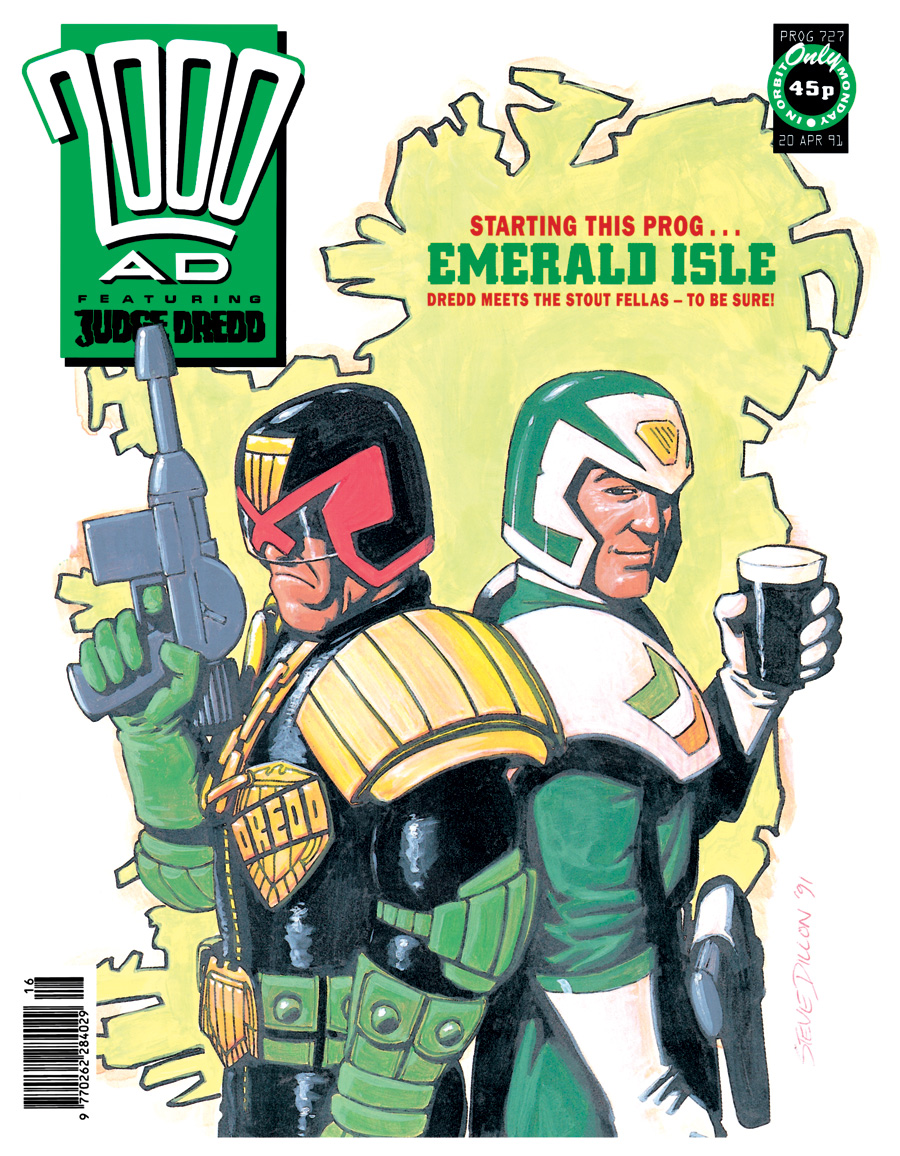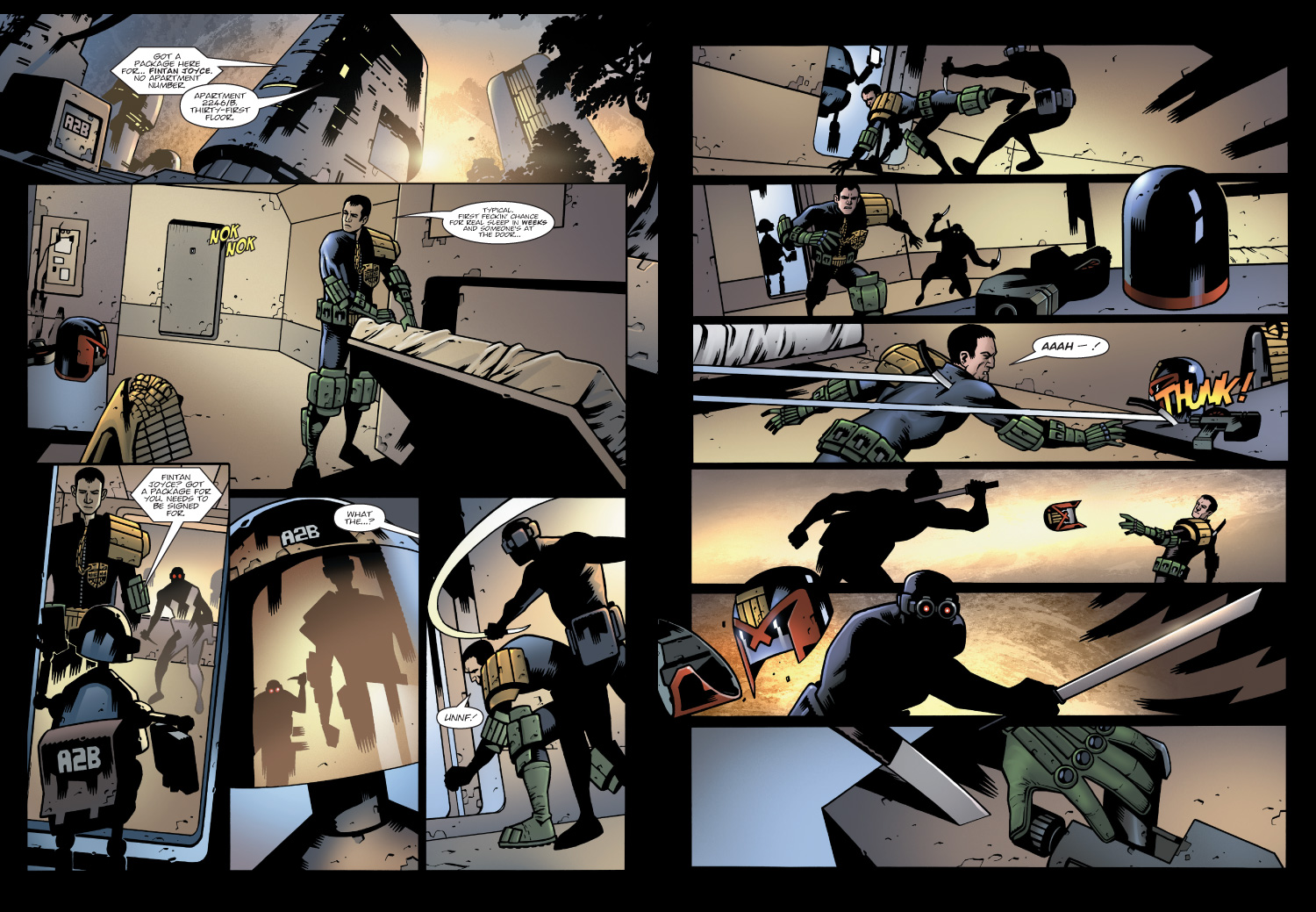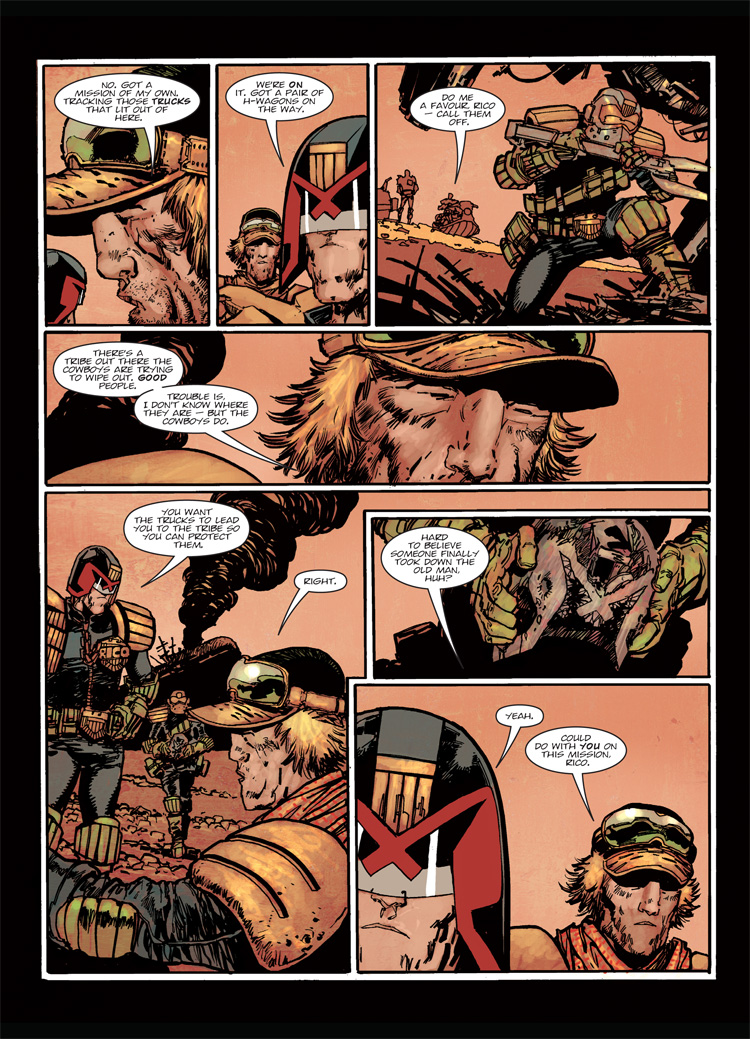“I reckon it’s safe to say that it’s not all over yet” – Carroll on Judge Dredd: Every Empire Falls
9th February 2017
Following the decimation of Mega-City One during Chaos Day, Judges from other friendly Justice Departments have been brought in to strengthen the ranks and help maintain law and order on the streets. Amongst the newcomers is Fintan Joyce son of a former Emerald Isle Judge, who teamed up with Judge Dredd in one of the most fondly remembered Dredd stories.
Exploiting the Big Meg’s weakened state, several groups have risen up against the Judges, including the Goblin King s Undercity army and a mutant group lead by the monstrous Thorn, who have been attacking Cursed Earth outposts. If things couldn’t get any worse, Dredd has fallen foul of Brit-Cit and they want him in prison or on a slab Have the odds finally stacked up enough to spell the end of Mega-City One s greatest lawman?
Every Empire Falls is writer Michael Carroll’s fascinating multi-part epic about Mega-City One’s struggles to survive in the wake of the Day of Chaos, with stellar artwork by Henry Flint, Paul Davidson, Carlos Ezquerra, Colin MacNeil and PJ Holden.
With the collected edition out this week, Carroll spoke to the 2000 AD blog about writing this modern epic and the implications for the future of Dredd and all the characters involved…
Q. The first story in this collection introduces Judge Fintan Joyce, the son of Charlie Joyce from the fondly-remembered Emerald Isle story from 1991 – as a citizen of Murphyville yourself, how influential was that story on you, both as a fan and as a creator?
A. I remember loving the story at the time: Garth Ennis has a deliciously twisted sense of humour, and the art by Steve Dillon and Will Simpson is just magic. But there were certain aspects that I felt were a little too broad – the potato-gun, for example, was a gag too far given that much of the story dealt with the Murphyville residents trying to shake negative stereotypes foisted on them by a more powerful nation. When I was brought on board as a Dredd writer one of the first things I wanted to do was revisit the Emerald Isle and maybe address some of that.

After Day of Chaos, with most of Mega-City One in rubble and the Justice Department severely depleted, I figured that it would make sense to draft in Judges from other cities. I wanted an Emerald Isle Judge, but Charlie Joyce would be too old: someone younger and more impressionable would be better. So I decided that Charlie would have a son who’d been an Emerald Isle Judge for only a few years – not long enough to pick up too many of his old man’s bad habits!
Later, with Blood of Emeralds, I brought Dredd and Joyce back to the Emerald Isle to see how much it had changed in the quarter-century since Garth, Steve and Will had been there… And that allowed me to start widening the scope of my Dredd stories a little. I’ve always felt that a city-state as powerful as Mega-City One would be pretty much like the USA today: it would have a massive impact on the rest of the world without even really being aware of that. Sure, in MC1 they know they’re the best (and won’t stop telling everyone else), but they’re always looking down: they don’t have the ability – or see the need – to put themselves in the shoes of their contemporaries and look up.

And it could be argued that the inhabitants of the Emerald Isle see themselves as superior to the Brits because the Brits spent centuries subjugating them, and in Brit-Cit they see themselves as superior to the Emeralds for precisely the same reason…
Q. In Judge Dredd, possibly more than any other story in 2000 AD – and arguably more than another comic-book strip – actions have consequences…
A. Exactly! Dredd ages in real-time and there are no reset-buttons or reboot, so everything that happens stays happened, if you’ll pardon the awkward phrasing. Some comic-books might set up plotlines up to a year in advance, but the classic Day of Chaos epic was the pay-off to decades of Mega-City One / East-Meg hostilities, and I reckon it’s safe to say that it’s not all over yet.
I’ve been reading 2000 AD from the very beginning, so it’s been a huge part of my life, and Dredd’s been there all the way. I wouldn’t say he’s like an old friend – more like a disapproving scary neighbour on top of whose garage my Space Spinner still resides – but what I love about him is that he’s weathered forty years of ongoing continuity without breaking a sweat. We’ve seen cities rise and fall, despots come and go, we’ve seen fads and trends and plagues and invasions and everything else, and Joe Dredd is still the same old grumpy fecker he’s always been.
I’m sure that by now his hair – if he has any left – is white, and that there are many lines around his eyes (even though we’ll never get to see them), but at the core, Dredd is Dredd. He is the bedrock of Mega-City One: the city is chaotic, Dredd is solid. He’s not utterly immutable, of course, but he evolves at the speed of a glacier stuck in the mud.
That’s why it’s fun to pair Dredd with characters who can be flippant at times: Anderson and Koburn are perfect examples. They’re good at their job and Dredd will admit that even if he doesn’t like the way they get the job done. And at the start Judge Joyce clearly idolises Dredd and can’t stop himself from trying to impress him, and can’t see that’s exactly the sort of thing that won’t impress him.
Q. There’s a lot of political intrigue in the story… How do you avoid that swamping the action and the flow?
A. Well, I’d say that there’s always politics in any Dredd tale, though sometimes the political aspect is very deeply buried! In this case, I had no choice at times but to be blatant, particularly when Texas City’s Chief Judge Oswin comes to Mega-City One.
I’m sure that no one wants to read the Dredd equivalent of a ten-hour House of Lords debate, so the way around that is to illustrate the politics through their impact on ordinary people… The mutie on the street, so to speak. Right from the start of this collection, we see the Judges imposing their will on the denizens of the Undercity: any right-thinking person (ah, now there’s a politically-charged phrase!) would of course understand that the Judges have no moral right to pass judgement on the people they’ve discarded and shunned.
Same goes for the folks out there in the Cursed Earth, barely scraping together a living. Along come the Big City Judges with their guns to start barking orders and throwing their weight around… Acting like they own the place, until it suits them to go home to their pristine cockroach-less apartments and forget about the rest of the world.
Politics can be dull when it’s some otherwise-unemployable wealthy spugwit standing up in Parliament and smugly addressing her fellow wealthy spugwits, but it becomes much more interesting when the rules she passes filter down to the people who have to find a way to live with them!
Q. Without spoiling too much for anyone who’s not yet read it, do you have any favourite moments in Every Empire Falls?
A. The interaction between Rico and Koburn in Dust to Dust was a lot of fun: I’ve never had a chance to write either of them before. In an early draft of the script Koburn kept referring to Dredd as Rico’s father, just to get a rise out of him, but I dropped that because I felt Koburn was being a little disrespectful. Sure, he and Dredd never got on, but there was always mutual – if grudging – respect.

I also enjoyed taking Joyce through Brit-Cit, which I pretty much envisaged as present-day London because it’s such a mad, fun and barely-sane city as it is: why change that? PJ Holden and I threw lots of little gags into the background: the “Dave’s Pork Pies” balloon was one of his, I liked that one a lot. And the bakery called “Staples” was of course a reference to another Dredd artist… Careful scrutiny of that panel will reveal that the bakery is selling “Hover-buns” because this is, after all, the future.
But the best part of the whole process was, for me, finding out that Carlos Ezquerra would be drawing the final part of the saga. The man who co-created Judge Dredd drew a strip based on words that I wrote – I still can’t believe that!
